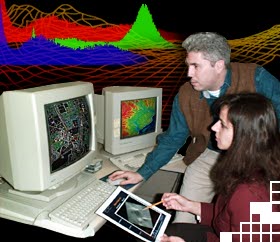
| Table of Contents |
| 1. Introduction 2. Sensors 3. Microwaves 4. Image Analysis 5. Applications |
Fundamentals of Remote Sensing
4.3 Answers

If we have seven bands of TM data, each 6000 pixels by 6000 lines, and each pixel takes up one byte of disk space, we have:
7 x 6000 x 6000 = 252,000,000 bytes of data
To convert this to kilobytes we need to divide by 1024, and to convert that answer to megabytes we need to divide by 1024 again!
252,000,000 (1024 x 1024) = 240.33 megabytes
So, we would need over 240 megabytes of disk space just to hold one full TM image, let alone analyze the imagery and create any new image variations! Needless to say, it takes a lot of storage space and powerful computers to analyze the data from today's remote sensing systems.
Back to the question...
| Updated2002-08-21 | Important Notices |
